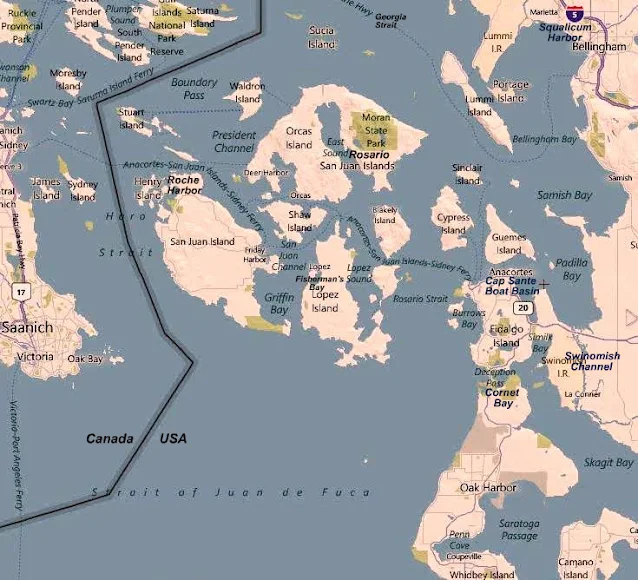Note: this is a very old post I am re-posting so some prices will be off.
Suggested Cruise to Victoria BC with Whale Watching
and San Juan Islands Stop Overs
This article is for first timers to the San Juan Island area and has the answers you may be looking for. Timeless advice to make your first trip a fun success.
- places to launch and stay on your boat
- distances between stops
- customs and immigration
- alternate planning
- what to expect
- basic boating information
Study this map and familiarize yourself with names and places.
(Find Victoria, Roche Harbor, Swinomish Channel, Deception Pass)
Lets start this Cruise at Cornet Bay in Deception Pass State Park
(Your going to Canada and back, did you remember to bring your passports and Children ID's? the rules are changing)
Boat launch at Cornet Bay (Deception Pass)
Day one, you arrive at Deception Pass and its probably late in the day and your tired, so lets plan on spending the night right here on the boat securely tied to the dock at Cornet Bay. You will pay a launch fee and $10/day parking, plus 50 cents a foot for spending night at dock. Pay at the self serve kiosk. If your not sure of when your coming back simply estimate, leave a note explaining, the ranger will understand. The ramp is very good, all tide. The parking is huge, you will not have a problem.
There is a park store, but you should have done your provisioning in Anacortes.
Heading westward facing an incoming current, (another ten minutes and we wouldn't have the speed to overcome the 7+ mph current)
Day two, leg #1, our destination is Friday Harbor, but first you must time the pass. You should already be familiar with the tide levels and times at Deception Pass (download a page from any of of dozens of sites including NOAA) so cast off at high or low tide. You can be half an hour early or late, this gives you a one hour window. (it takes just ten minutes to reach the pass from the dock) If you are catching a falling tide (current is going out to sea) you can be very late but standing waves may scare you and the crew as you take a fast sled ride and shoot out into the Strait of Juan De Fuca. If you are late and head out on a rising tide, your boat may not have enough speed to overcome the in rushing torrent, and your stuck until the next slack water. The pass is not a problem, it is narrow with fast water for only about 250 feet, but slow sailboats can meet their match every four to six hours.





